Fairfield Farms Dairy Cooling Station Detour
Building Pictures / Description
-
Colorized copy of the image found in Carroll County Times and also "Farming in Carroll County" book.
Photo credited to Nancy Eyler (volunteer at Taneytown Museum)
Richard Wilhide believes the original office was tar paper covered.
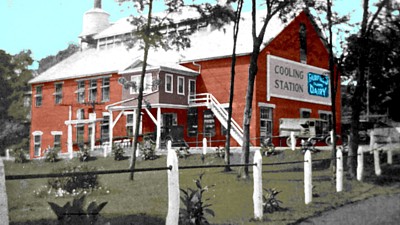
The newspaper dates the pic as 1922 but there's a 1930's car under the office.
Also original land purchase was 1923 and steam powered cooling/ice equipment added 1924.
Note the line of milk cans in front of the car. These were not insulated.
- Photo credited to Jim Cushon owner of Medford Trains
Very rare view of the track (north) side of the building. Current pic to the right for comparision.
I originally thought this was early 1930's but there is significant brush growth and some of the window screens are in the same position to this day.
This suggests this may have been taken during the 10 years between the plant's closing and sale.
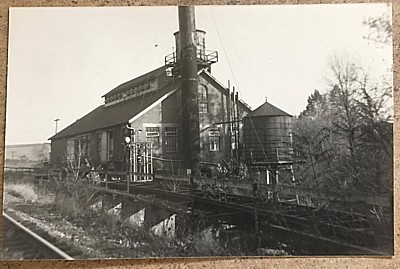
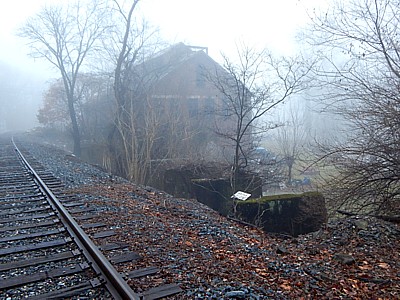
Note that while it appears that the siding may have been a loop,
Richard Wilhide confirmed it went across Keysville Rd but was single ended.
He and others would play on cars while the locomotive would go all the way to Emmitsburg Junction
(Rocky Ridge Wye) to turn around and come back to the plant.
- Current pictures of the West/North sides of the building
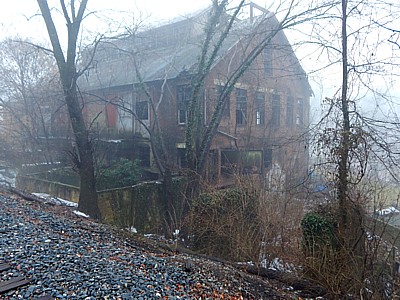
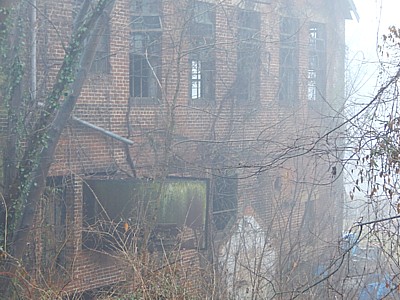
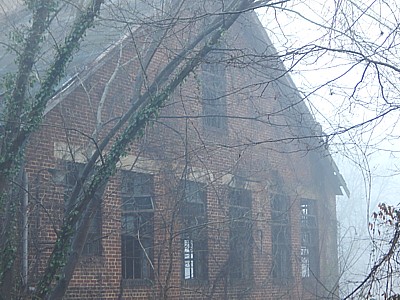
- WM indust dairy Western Maryland-Sealtest 1984-01-19, Detour MD, from slide, Charlie Hill foto
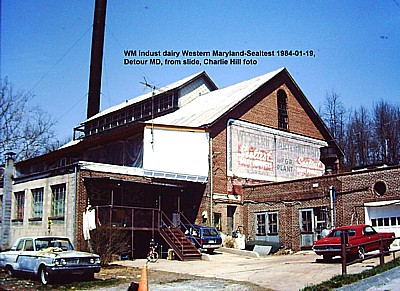
2nd floor/attic addition of residence under construction,
According to Richard Wilhide when the warehouse that has become the residence was added the office remained.
The white framed window/door in the shadows may be remains of original office.
The doors/windows intact on powdered milk building, Water tank gone
Smoke stack still standing, according to Richard Wilhide this had to be replaced while the plant ws still in operation.
- Photo credited to Glen Stegmiller owner of Moose Caboose Winfield from when he worked at MMID in 1980's
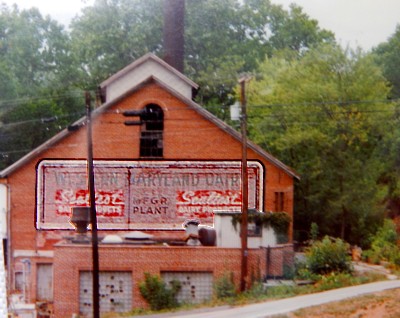
Notes: Main smoke stack still standing, doors on main building still intact.
Equipment still on roof of powered milk building and glass blocks still in it's windows.
- railroadnet pics of MMID F7 going past creamery late 1980's-90's
http://www.railpictures.net/photo/293209/ April 10, 1986 - Vince Hammel Jr
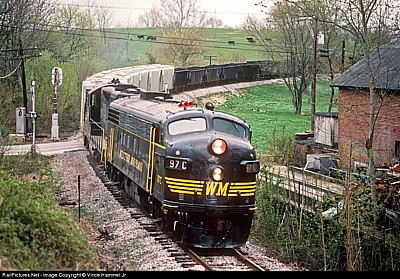
Notes: Concrete siding before collapse.
- https://www.facebook.com/photo.php?fbid=1654479817906551&set=gm.10154900816311044&type=3&theater&ifg=1Arthur House
A Maryland Midland passenger extra burnishes former Western Maryland East Subdivision rails at Detour, Md., in May 1992.
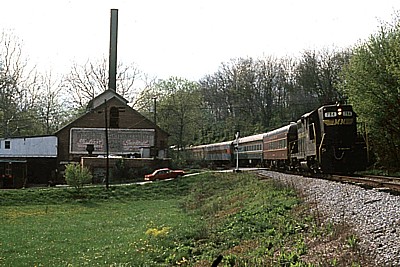
Notes: Concrete siding may have collapsed. Smoke Stack intact.
- https://www.flickr.com/photos/112247008@N06/16537860857/in/photostream/lightbox/ Vince Hammel
https://c2.staticflickr.com/8/7635/16537860857_991c24ca99_b.jpg
MMID 100 pulls an eastbound Entertrainment lines excursion by the old Western Maryland Dairy at Detour, Md.
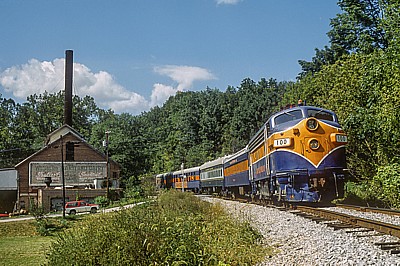
Notes: The EnterTRAINment Line ran From 1990 to 1995, so it has to be from those years.
Building doesn't look much different than the 1984 pic.
- Street view pic from Jim Cushun date unknown
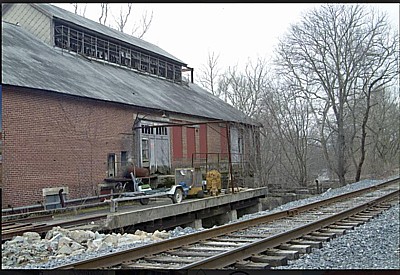
Notes: siding collapsed, stack gone
- Google street view pic January 2012
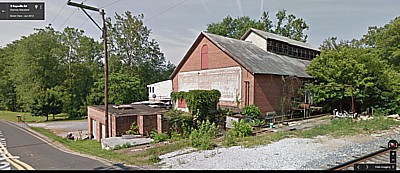
Notes: siding collapsed, stack gone
- Google street view pic January 2012
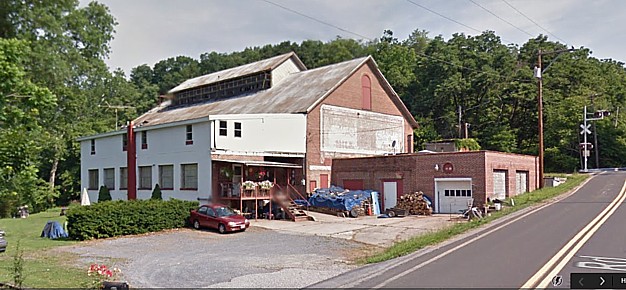
Notes: Round hole over garage door, gable end window and multiple doors covered with red barn metal
Glass blocks replaced with cinder blocks, addition block wall painted white, chimney red
- The main visually significant part of the roadside is a large sign painted on the brick.
There were at least 3 changes since the original Fairfield Farms Cooling Station sign.
The main visually significant part of the backside is a pair of herringbone pattern siding barn doors.
There is a siding level with the second floor and it used to have concrete in between and on the sides of the rails.
I didn't think the concrete was meant for much more than human traffic and man pushable freight.
Richard Wilhide stated that this was originally open like the rest of the trestle.
The concrete was addded to allow larger modern tractor trailer milk trucks to back in.
A power company bucket truck backed onto the siding in the late 1990's and the concrete collapsed.
The truck ended up axles resting on the rails and ever since it has become a broken concrete dump/fill site.
Originally I thought the whole underside of the siding was open and another storage yard.
Comments from Richard and some closer looks have confirmed the building has windows underneith the trestle.
The ground under the trestle has always just been an embankment.
- 06-04-2016 talked to ladies on front porch and only thing left in large factory part is "main hopper". Wouldn't trust floor..
They have no info on the property.(No computers or internet either)
Need, Construction, Decline and Closure
- What lead to the construction of this building?
Big cities growing population and decrease of local farms and dairies in and around the cities.
Demand for milk grew local supply couldn't keep up.
Poor conditions at dairies near major cities caused epidemic deaths and public outrage.
Railroads offered cleaner milk from better farm far from cities but transporting caused spoilage.
Large dairy corporations bought/shipped milk from many different locations, transported by rail and processed at large city plants.
Railroad hauling raw milk from local Carroll/Frederick county to Baltimore city and it spoiling lead to Health Department enforcement.
At the same time technology created means of replacing natural ice.
Local inventor combined steam power and ammonia refrigeration to make widespread installation of ice plants possible.
A local ice plant offed a way to keep milk cool from the cow and throughout the transportation process.
Environmental pollution and investgation of it lead to additonal process at this facility to dry whey into powder form.
- What lead to the closure of this building?
Rural electricity enabled every dairy farm to have on site cooling and other modern equipment
(In 1948, 87% of Carroll County farms were electrified, making practical/affordable on site cooling a reality.)
As local large dairy corporations got bought by the National one, the plant's existance became short lived.
(October 1, 1956 Western Maryland Dairy merged w/ National Dairy, Detour's dairy closed in 1958.)
National Dairy forced many small local farms out of business and encouraged onsite cooling equipment at the larger surviving farms.
At the same time the corporation became less interested in plain milk business and more in highly processed profitable products (cream cheese, dry mac&cheese etc).
Local dairies used the plant, National no longer saw the need for them, the plant or their produce as it moved to other markets.
- pg36 through 40 from the 1920 book The Butter industry describe the creamery perfectly.
The small local creamery (Detour) depends for its main supply of milk or cream on a very limited localized territory must obviously be located as near that supply as possible.
A large centralized plant (main plant in Baltimore) whose supply territory covers wide area, and that recieves the great bulk of its raw material by rail,
is compelled to give first consideration to a suitable railway (Western Maryland RR).
The creamery large or small needs a plentiful supply of clean, pure water, free from pollution with organic matter, and objectionable minerals such as iron and sulpher.
pg37 The disposal of creamery waste is exceedly important. A creek or river with running water throughout the year (Double Pipe Creek),
pg40 Locate windows high to keep flys away from product. Lots of ventilation.
-
https://www.northcountrypublicradio.org/news/story/34034/20170714/early-milk-transportation-dairy-plants-from-the-1800s-to-the-1930s
-
http://www.hsccmd.org/Documents/Carroll%20County%20Times%20Yesteryears/2013/10-13-2013.pdf
In 1889, the same storm which caused the infamous Johnstown Flood also caused devastation along Double Pipe Creek.
Nothing serious occurred again until 1933. wikipedia 1933 Chesapeake–Potomac hurricane
In the 1920s and 1930s, a milk plant called Fairfield Farms Dairy employed about fifty local people
and processed 27,000 gallons of milk daily which came from surrounding farms.
- 1949 sited for Monocacy polution along with a bunch of operations throughout MD and PA
https://www.newspapers.com/newspage/8918166/
December 10, 1949 - The News from Frederick, Maryland · Page 3
Industrial, Sewage Pollution Contribute To Condition Of Monocacy, Survey Discloses.
This is the third of a series containing factual data presented at the organization meeting of
the Monocacy River Watershed Council at Westminster on November 10.
Western Maryland Dairy. Detour -- Cesspool and discharge to Double Pipe Creek Additional treatment necessary.
Carroll and Frederick County Canneries
By Harry Conover, John H. Foertschbeck, Sr. Describes the demise of the local canning industry
- wikipedia - Whey
Whey is the liquid remaining after milk has been curdled and strained.
It is a co-product of the manufacture of cheese or casein and has several commercial uses.
Sweet whey is manufactured during the making of rennet types of hard cheese like cheddar or Swiss cheese.
Acid whey (also known as "sour whey") is a co-product produced during the making of acid types of dairy products such as cottage cheese or strained yogurt.
Skim Milk Powder Vs. Whey Protein Powder
"Whey powder is a common protein supplement made by dehydrating whey, the liquid byproduct of cheese production.
Skim milk powder, another milk-based protein supplement, is made by dehydrating milk after the removal of the majority of its milk fat content.
While both are excellent sources of protein, the type of protein and nutritional content of whey and skim milk powders differ."
Powdered Milk was probably Whey Powder?
- https://en.wikipedia.org/wiki/Maryland_Midland_Railway
Operations began in 1980 over a section of ex-Pennsylvania Railroad's Frederick Secondary line from Taneytown to Walkersville, Maryland.
Starting in 1983 the ex-Western Maryland Railway line from Emory Grove to Highfield was purchased from CSXT in sections.
Glen worked for MMID prior to EnterTRAINment
From 1990 to 1995, the EnterTRAINment Line provided passenger excursions on the Maryland Midland Railway system.
Glen has pics of when MMID F7a #100 first came out of paint booth.
http://www.railpictures.net/photo/565293/ MMID blue and Orange dates back to at least November 1980
https://books.google.com/books?id=szRCAQAAMAAJ&pg=RA3-PA67&lpg=RA3-PA67&dq=a+milk+plant+called+Fairfield+Farms+Dairy&source=bl&ots=xxreYvDsq-&sig=QcwxRbt1P7kM0AQSzk1vMXZL7vI&hl=en&sa=X&ved=0ahUKEwj25pez35nNAhXG1B4KHf4MDzMQ6AEIKjAD#v=onepage&q=a%20milk%20plant%20called%20Fairfield%20Farms%20Dairy&f=false
Created: 06-04-2016 09:13AM
From notes document created: 06-02-2016 14:44PM
Modified: 06-12-2016 13:11PM
Modified: 06-12-2016 16:52PM
Modified: 06-14-2016 15:42PM
Modified: 04-09-2017 09:42AM
Modified: 11-01-2017 19:51PM
Modified: 11-02-2017 07:24AM,13:21PM
Modified: 11-03-2017 09:45AM
Modified: 11-03-2017 12:36PM
Modified: 11-15-2017 09:29PM
Modified: 01-22-2018 03:47PM
Last Update:













